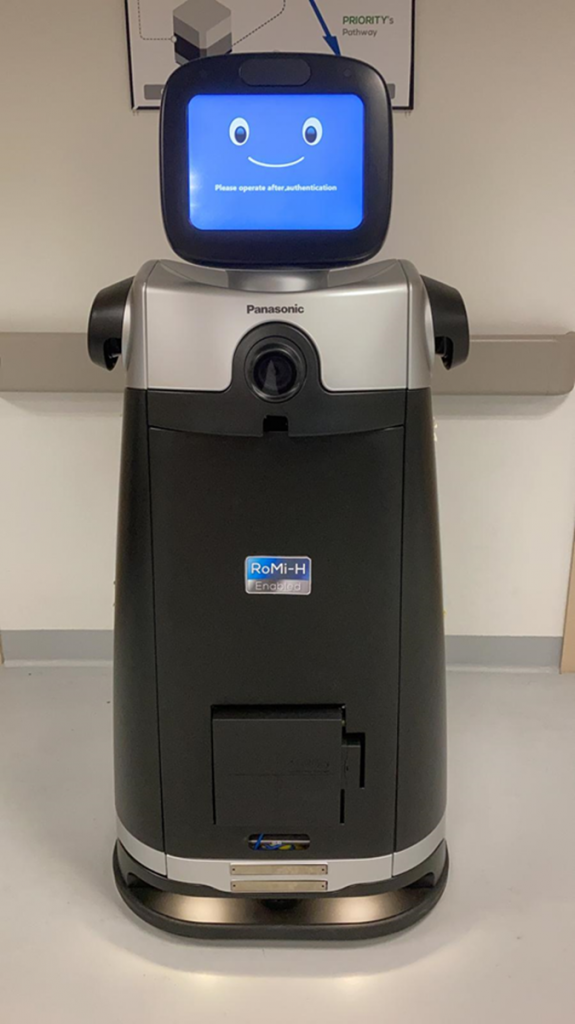
Our Activities
Panasonic R&D Center Singapore Is making significant contributions to the RoMi-H ecosystem
April 20, 2021 |
Delivery Robots and other automated smart devices are increasingly being deployed in hospitals to improve operational efficiency and, in turn, provide better healthcare overall. However, when many of such robots from different Autonomous Mobile Robots (AMR) vendors occupy a shared environment, several problems arise. These problems such as task scheduling or prioritization and conflict resolution are unavoidable.
As an increasing number of hospitals, as well as other public spaces, rapidly adopt automated solutions in light of recent events such as the Covid-19 pandemic, these problems become more apparent and significant. Many international organizations are concentrating their efforts to develop middleware that will integrate automated devices in smart buildings. One such effort is RoMi-H (Robotics Middleware for Healthcare).
What is RoMi-H?
Jointly funded by the Singapore Government (Ministry of Health (MOH) and the National Robotics Program (NRP), the RoMi-H project started in July 2018. Led by Singapore’s Centre for Healthcare Assistive and Robotics Technologies (CHART) in collaboration with other solution providers, RoMi-H aims to provide a unified approach to communication and monitoring across different robot platforms, intelligent sensors, smart building infrastructure (lifts/doors), and enterprise information systems.
What are its features?
RoMi-H is open-source and therefore has considerable support from the community. It uses ROS2 (Robot Operating System 2) which allows for real-time, secure, reliable and efficient communication and data routing. Developers can utilize its tools such as the Traffic Editor to create a simulated building environment on the Gazebo simulator for quick development offline. It also provides a web-based dashboard for fleet monitoring purposes. RoMi-H strives to be a “vendor agnostic” and “interoperable communication system” for heterogeneous robots, sensors, and information systems in the healthcare space. For more details and other features, you can refer to the ROS Multi-robot book.
(Link: https://osrf.github.io/ros2multirobotbook/)
How Panasonic R&D Center Singapore’s is actively contributing to the RoMi-H ecosystem
Panasonic is one of the initial companies to be certified as a RoMi-H empanelled systems integrator. This is used for robots that already have a well-developed fleet management system such as Panasonic’s existing HOSPI robots.
Panasonic R&D Center Singapore and the Manufacturing Innovation Centre (part of Panasonic Asia Pacific) are collaborating with Open Robotics to provide full support for the development and testing of the Traffic Light Adapter (medium control). Panasonic is one of the first robot manufacturers to have successfully demonstrated the Traffic Light Adapter with RoMi-H at the CHART Labs.
Panasonic also works with other RoMi-H related solutions providers, such as Xynergy which provides wireless battery-charging technology. The Xynergy wireless battery-charging station will be used as a universal battery charger that can charge different types of robots. It understands which robot is coming to the station by interacting directly with the RoMi-H server. Panasonic’s HOSPI robot is one of the first robots to test and demonstrate the Xynergy wireless charging system.
Considering its immense potential in impacting the existing automation set up in hospitals and its ability to expand to other significant public spaces such as airports and shopping malls, Panasonic will continue to focus its efforts on establishing itself as a pioneer developer and adopter of the RoMi-H technology.


Related Posts

Panasonic R&D Center Singapore Is making significant contributions to the RoMi-H ecosystem
Delivery Robots and other automated smart devices are increasingly being deployed in hospitals to improve operational efficiency and, in turn,…
Read more
People Before Products
The exponential pace of progress in Artificial Intelligence has led to an increasingly worrying narrative on the ethics and regulatory…
Read more
Bosco App: Cyber-well-being for your child using AI
Utilizing our deep learning based technologies for multimodal processing of image, text and video contents, we provide machine intelligence backend…
Read more
R&D in AI for Commercial Products
The evolution of Artificial Intelligence (AI) and deep learning is adding a new dimension to user value and experience, which…
Read more




